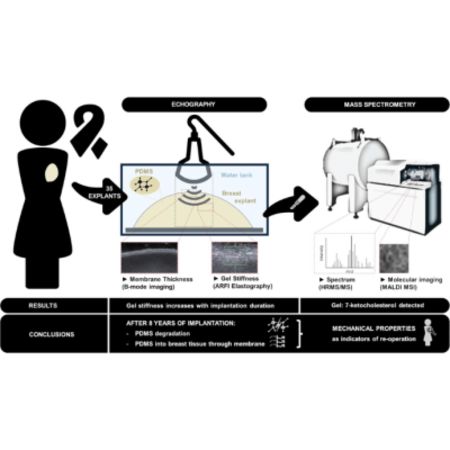Breast cancer affects over 58,000 people annually in France, with one-third of cases requiring total surgical breast removal (mastectomy) and 30% of patients opting for breast reconstruction post-mastectomy. However, concerns arise regarding the longevity and safety of breast implants, with reoperation often necessary every 10 years. Complications and potential mortality linked to implants have spurred research into understanding the mechanisms of implant aging.
Ultrasound elastography to measure implant stiffness
A research team from Strasbourg, France, led by Dr Laetitia Ruffenach, recently published in the Journal of Biomechanics a study focusing on the mechanical evolution of breast implants over time. Researchers investigated 26 breast explants implanted in patients for up to 17 years, along 9 new implants. Utilizing Acoustic Radiation Force Impulse (ARFI) ultrasound elastography, a non-destructive imaging method, they observed an increase in stiffness in the explants, particularly after 8 years of implantation.
Stiffness increase leads to implant rupture risk
The study highlights a significant correlation between implantation duration and stiffening of the implants, potentially increasing the risk of rupture. This stiffening, attributed to changes in the gel within the implants, could compromise their mechanical flexibility, further elevating the risk of rupture. Moreover, the analysis of gel samples from the explants revealed the presence of cholesterol metabolites originating from breast tissues, which likely degrade the gel. This finding suggests a potential mechanism contributing to the observed increase in stiffness and subsequent risk of rupture. The team highlighted that an explant carried for 210 months is three times stiffer than for 38 months.
Research needs to be extended to more implant types
While the study presents promising insights, it also acknowledges certain limitations. The inability to assess ruptured implants due to administrative and legal constraints hinders a comprehensive understanding of implant aging. Additionally, the study primarily focused on textured implants, with a need for further research on non-textured implants to validate the findings across different implant types.
Non-invasive elastography can help to diagnose the need for implant replacement
Despite these limitations, the study underscores the potential of ultrasound elastography as a diagnostic tool for evaluating breast implant integrity and predicting the risk of rupture. By monitoring mechanical changes in implants over time, clinicians may better assess the need for implant replacement, improving patient safety and outcomes. The findings of this study offer a glimpse into the complex dynamics of breast implant aging and raise important considerations for future research and clinical practice. As discussions continue on the criteria for implant replacement, advancements in diagnostic techniques hold promise for enhancing patient care in breast reconstruction post-mastectomy.
Source & Image Credit: Journal of Biomechanics

























